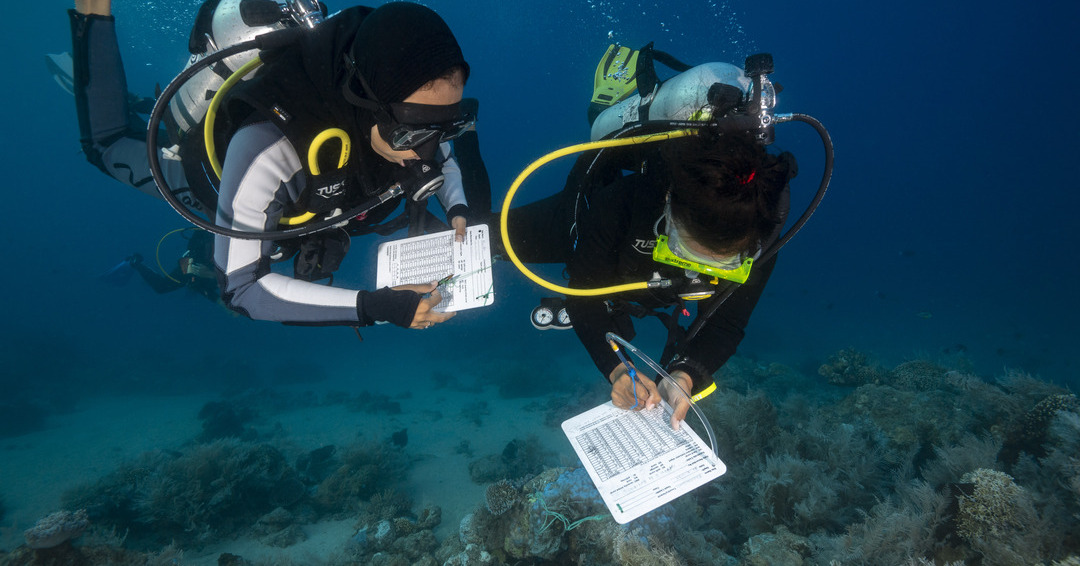Project title: Coral spawning monitoring and awareness for restoration network Indonesia
Project lead: Dr. Mareike Huhn
Co-applicants: Dr. Joana Dias, Ms. Priska Widyastuti, Mr. Alexis Chappuis, Dr. Frederic Sinniger Harii, Dr. Saki Harii, Dr. Gino Limmon, Dr. Douglas Fenner, Mr. Budiono Senen
Countries involved: Indonesia, France, Germany, Japan, USA
Takes place: Maluku, Indonesia and Okinawa, Japan
Supporting institutions: Ruhr-University Bochum (Germany), Luminocean – Yayasan Cahaya Samudera Indonesia (Indonesia), UNSEEN (Underwater Scientific Exploration for Education, France), University of the Ryukyus (Japan), Universitas Pattimura (Indonesia), NOAA (USA), Universitas Banda Naira (Indonesia)
Total budget: USD $653,183
Duration: September 2024 – August 2027
Project overview
Indonesia, with over 17,000 islands and 86,700 km² of coral reef, faces significant challenges in marine monitoring and conservation. The surge in coral reef restoration projects over the past decade, driven by tourism, has often been conducted without scientific oversight. Many of these projects are poorly maintained, with low transplant survival rates and limited follow-up. Restoration efforts are usually isolated, with little information exchange, and many projects are short-lived, rarely extending beyond a year. The lack of standardized methods and limited knowledge about coral spawning patterns further complicates these efforts. Additionally, language barriers and a scarcity of practical training in coral restoration best practices hinder the success of these initiatives. A thorough understanding of coral spawning patterns, particularly in the under-researched Mesophotic Coral Ecosystems (MCEs), is essential for planning effective and sustainable restoration projects.
The COSMARINDO project aims to improve coral restoration efforts in Indonesia by developing a nationwide network of students and researchers to monitor coral spawning events. This network will contribute data to an open-access database, enhancing the understanding of coral spawning patterns across Indonesia’s vast reef systems. By focusing on capacity building and education, the project seeks to create a sustainable future for coral restoration in Indonesia, with an emphasis on scientifically informed practices. The project will also compare spawning patterns between shallow and mesophotic reefs, providing critical insights into the reproductive strategies of corals in these different environments.
Specific Objectives
- Develop a nationwide student network for monitoring coral spawning: involving six universities
- Train Indonesian students in coral restoration and raise awareness: by delivering English and Indonesia in-person and online workshops
- Compare coral spawning patterns between shallow and mesophotic reefs: by using a camera-based monitoring tool.
How the Objectives Will Be Met
- Building the Student Network:
- Involve six universities across Indonesia in monitoring coral spawning.
- Deliver workshops (English and Indonesian) to train participants in coral identification and spawning monitoring using egg traps and time-lapse night vision cameras.
- Establish a centralized, user-friendly database where participants can freely access and contribute data.
- Training and awareness:
- Conduct workshops with a focus on the benefits and drawbacks of various methods, coral spawning, larval propagation, and monitoring settlement and growth to educate students on coral restoration techniques, emphasizing the pros and cons of various approaches and the importance of sustainable practices.
- Provide hands-on training in coral spawning, larval propagation, and monitoring techniques.
- Comparative study of spawning patterns:
- Research the spawning patterns of mesophotic corals and compare them with those of shallow water species.
- Develop a camera-based monitoring tool that can be deployed for extended periods at depths of up to 80 meters.
- Train students in safe deep diving techniques.
Impact of the Project
The project is expected to lead to the following outcomes:
-
- Conduct eight workshops involving 28 students.
- Produce a regional species catalog.
- Clarify the reproductive strategies of five coral species.
- Record the first documented spawning event of mesophotic corals on camera in Indonesia and identify their spawning season.
- Develop a framework for teaching coral identification and spawning monitoring to Indonesian students.
- Establish a coral reef awareness network and a citizen science platform.
- Create a user-friendly app (available on Android, Mac, and browsers) for coral spawning data entry and maintenance.
- Produce coral spawning calendars for various sites across Indonesia.
Major Highlights
-
- Development of a comprehensive network involving students, early-career and senior researchers, international experts, and private stakeholders.
- Creation of a citizen science app to connect universities and monitoring groups across Indonesia.
- Alumni of the program will serve as scientific advisors for restoration projects conducted by the government, private sector, and NGOs.
In 2025:
✅ Launched CORALog app for spawning data collection
✅ Trained 120+ students in coral identification and spawning monitoring
✅ Established a national network of 6 universities and 45+ active participants
Photo credits: divers by Alexis Chappuis.

